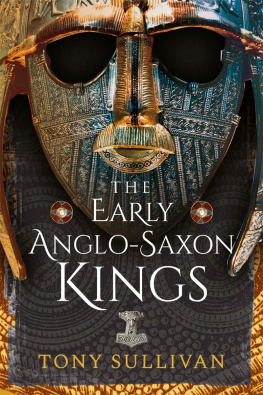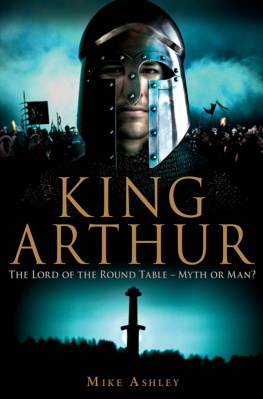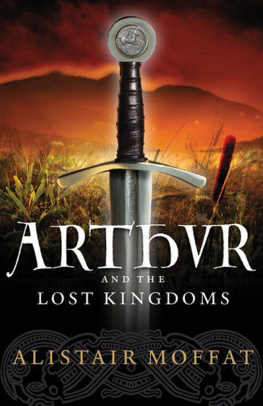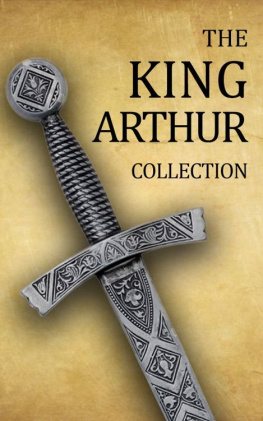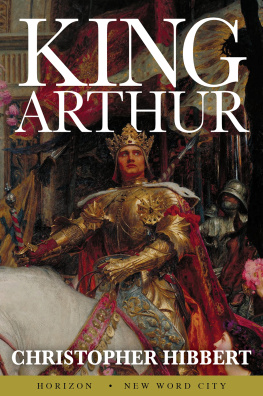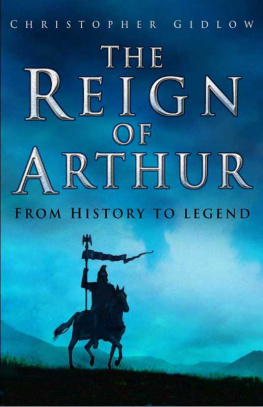
KING
ARTHUR
KING
ARTHUR
MAN OR MYTH?
TONY SULLIVAN
First published in Great Britain in 2020 by
PEN AND SWORD HISTORY
An imprint of
Pen & Sword Books Ltd
Yorkshire Philadelphia
Copyright Tony Sullivan, 2020
Hardback ISBN: 978 1 52676 367 9
Paperback ISBN: 978 1 52676 371 6
The right of Tony Sullivan to be identified as Author of this work has been asserted by him in accordance with the Copyright, Designs and Patents Act 1988.
A CIP catalogue record for this book is available from the British Library.
All rights reserved. No part of this book may be reproduced or transmitted in any form or by any means, electronic or mechanical including photocopying, recording or by any information storage and retrieval system, without permission from the Publisher in writing.
Aura Technology and Software Services, India.
Pen & Sword Books Limited incorporates the imprints of Atlas, Archaeology, Aviation, Discovery, Family History, Fiction, History, Maritime, Military, Military Classics, Politics, Select, Transport, True Crime, Air World, Frontline Publishing, Leo Cooper, Remember When, Seaforth Publishing, The Praetorian Press, Wharncliffe Local History, Wharncliffe Transport, Wharncliffe True Crime and White Owl.
For a complete list of Pen & Sword titles please contact
PEN & SWORD BOOKS LIMITED
47 Church Street, Barnsley, South Yorkshire, S70 2AS, England
E-mail:
Website: www.pen-and-sword.co.uk
Or
PEN AND SWORD BOOKS
1950 Lawrence Rd, Havertown, PA 19083, USA
E-mail:
Website: www.penandswordbooks.com
Introduction
The figure of Arthur has fascinated people for hundreds of years. However, there is a discrepancy in how he is viewed between academic historians on one hand, and enthusiasts and amateur historians on the other. The fault lines do not bisect these two groups cleanly and there are nuances within each. However, a general consensus from the first group could be summarised as: there is no historical evidence and as such he should be treated in the same way as any other mythical character. In the other corner there are a veritable regiment of different Arthurs and theories. Proponents place these different Arthurs in every corner of the British Isles from Wales, Cornwall, Pennines, Midlands, and even Ireland. We also have a Roman Arthur along with others from the Continent, with particular focus on Brittany and Gaul. In addition, Arthur has been linked to more legendary and mythical figures, from not just the Celtic world, but beyond as far as Sarmatia on the Black Sea.
It is quite difficult for the lay person to sift through all the theories and evidence and determine fact from fiction, or evidence from speculation. The intention of this book is to do just that. I will approach the subject much the same way as a crime scene or fire is investigated; one can often discover the seat of a fire by examining the depths of burning in wood fixtures such as architraves and skirting boards. To put it simply, the greater the depth of charring, the nearer to the origin we are. Unfortunately with Arthur we have the opposite situation. The further from the source one gets in time, the more evidential fog one has to wade through. The nearer to the source one gets, the sparser the evidence. The historical record falls silent.
It is not enough to find the first appearance of the story and work forwards. This is not simply because the first mention of Arthur, around AD 830, placed him 300 years before that time. Because that evidence and dating within it is so suspect, we must go back even further to Roman Britain and work forwards so that we can see all the contemporary evidence as it appears. It must be remembered that absence of evidence is not evidence of absence, but nor must we forget that there is not a single contemporary record, either from Britain or the Western Empire, that mention Arthur. Given the plethora of books and competing theories, the intention is to approach it in a new and hopefully useful way.
I will attempt to treat the material in a scientific way and conduct a proper historical investigation. A good example, given the subject of Arthur, is the saying there is no smoke without fire; there is indeed plenty of smoke with this particular fire, especially from the Middle Ages, several hundred years after Arthur is supposed to have lived. Many point to all the legends and Welsh poems and claim there has to be something to it. However this approach is flawed historically and scientifically; therefore, I intend to be rigorous with the evidence and we may have to be brutal with speculation and hearsay. We will be focusing on original texts and contemporary evidence; later stories and legends written hundreds of years later cannot possibly have the same weight.
In a criminal investigation the police will collect evidence and then the CPS will decide whether to proceed on the basis that it is in the public interest and there is sufficient evidence. I would hope in our case there is still an interest. As to the evidence, I will attempt to present it in a slightly different way to some of the previous works. It will not start with a detailed investigation of stories written in the Middle Ages and then work backwards looking for links; rather, the evidence will be presented in a chronological order. This will mean it may take some time until we reach any references to Arthur at all. I would ask you to bear with this approach as the contemporary historical accounts are crucial in getting a clear picture of context.
Having discussed how we will go about the task, it would be useful to set out the order. A very brief outline of both the legend and the historical setting will be laid out below to aid understanding of what we are working towards and from where we should start our investigation. I will lay out the historical evidence starting from near the end of Roman Britain. That way one can see the body of evidence, or absence or evidence, as it builds. It also places the stories in their correct place: when they were written in the historical record, rather than placing them in the time about which they are written. As many of the stories come at the end of our chronology we will then investigate these legends. Finally we will then investigate some of theories resulting from these legends and look at some specific proposals for the figure of Arthur. Hopefully, in conclusion, we may end with a list of things we can say are supported by the evidence, and on the other end of the spectrum theories, totally unsupported. In between these two extremes there may be suggestions as to what further evidence would be useful and areas worth prioritising in the search for truth.
Before we start we need very briefly to cover two important topics and list some of the major questions that require answering. First: what do we mean by King Arthur? Second: what is the historical setting and background both before and during the period in question? The historical references are quite sparse. What people imagine when they hear King Arthur is the legend created by mainly French authors in the Middle Ages, after an enormously successful book of that time by Geoffrey of Monmouth in 1138. However, what most people are unaware of is that a lot of the story we associate with Arthur, like the Round Table, were added after Geoffreys book. In addition, a large part of that first story includes the invasion of the Continent and battles against the Romans. This important part is often ignored, but the connection with Gaul and the wider Roman Empire is vital in understanding this period.
Next page

